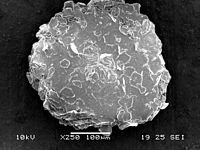
Photo from wikipedia
Atopic dermatitis (AD) is one of the most prevalent chronic inflammatory diseases. Head and neck (H&N) involvement, also known as the picture-frame pattern, can be a diagnostic and even therapeutic… Click to show full abstract
Atopic dermatitis (AD) is one of the most prevalent chronic inflammatory diseases. Head and neck (H&N) involvement, also known as the picture-frame pattern, can be a diagnostic and even therapeutic challenge. Sensitization to the fungus Malassezia furfur seems to be implicated in this clinical presentation. To investigate the role of Malassezia furfur in H&N dermatitis, we performed an observational single-centre study. Serum-specific IgE levels for Malassezia furfur were determined in a total of 25 patients with AD (15 receiving dupilumab treatment, 10 not receiving dupilumab), 14 patients with seborrheic dermatitis, and 19 healthy controls. Reactivity to Malassezia furfur, in terms of serum-specific IgE levels (>0.35 Ku.arb./L), was found in 80% of patients with AD. Risk factors to consider include high total IgE levels, sensitization to multiple pneumoallergens, and elevated LDH and CRP levels. Prescription of topical antifungals, oral antifungals, or a combination of both showed good response in 100% of cases in the H&N AD group treated with dupilumab. The most appropriate treatment seems to be the use of oral itraconazole and/or ketoconazole cream. The median treatment time was 3 weeks. Localized dermatitis in H&N significantly affects the patient’s life. We present a study of sensitization to Malassezia furfur in patients with H&N AD. It is important to know the differential diagnosis and to approach the study correctly. Sensitization to Malassezia furfur may be one of the main reasons, especially in patients being treated with dupilumab. The use of antifungals allows for adequate control, avoiding treatment changes and improving the patient’s quality of life.
Journal Title: Life
Year Published: 2022
Link to full text (if available)
Share on Social Media: Sign Up to like & get
recommendations!